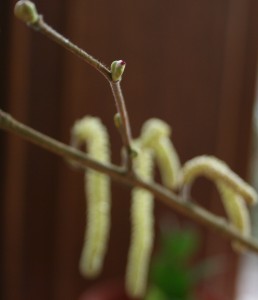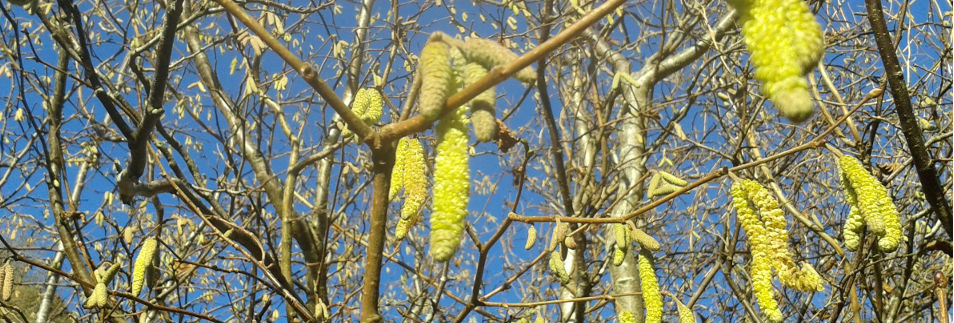The Latin name for hazel is Corylus avellana, Corylus from the Greek korys meaning helmet – a reference to the tough, helmet-shaped nutshell and avellana from the Italian town Avella where the nuts were once cultivated.
Because the common growth habit of the hazel is as a straggling, many-stemmed bush it is most often classified as a shrub. However, given a low-lying fertile soil and a benevolent climate, single stemmed specimens can reach heights of 6m in which case they are technically trees. For the sake of this article the hazel is a tree – a hardy and widespread tree, common on all soils except acid peats and often close to water. It is also shade-tolerant, growing well as an understorey tree in oak and ash woods or along woodland fringes. Hazel is deciduous; the matt-green toothed oval leaves turning many shades of golden yellow and brown in the autumn. When the leaves fall it is to reveal a smooth, brownish-red to greenish-brown bark with a burnished, almost metallic sheen.
For the bees
Hazel is wind pollinated so no nectar is produced but the bees work the male catkins for pollen. These are formed in the previous autumn and over-winter as clusters of fawnish grey, bullet-shaped projections. Generally from February onwards but on Christmas day this year (2013), and through to April in places, these gradually extend into the familiar catkin shape then open to release clouds of pale greenish yellow pollen.
The female catkins appear at the same time but they are very much smaller, inconspicuous bud-like constructions borne towards the tips of twigs and each equipped with a little tuft of crimson stigmas to catch wind-blown pollen grains – click photo below for bigger picture. Fertilised female flowers develop into hazelnuts, which ripen in October.

For man
At one time hazel was considered a very valuable tree and as such was often planted and coppiced regularly on a 7-15 year cycle. Left to its own devices it is relatively short-lived – only about 60 years – but when coppiced, it can live to be as much as 600 years, responding vigorously to each cutting by throwing up dozens of strong straight rods. Hazel rods have a multitude of different uses depending on their thickness and straightness.
Stouter poles can be used for fencing, furniture or firewood while whole or split wands can be woven to make fencing panels and hurdles for the penning of sheep, wattles for ‘wattle and daub’ plaster-work or strong baskets. Spars can be cut for use in the thatching of houses or ricks. Other uses included kindling, bean rods, plant stakes, pea sticks, hoops and clothes props.
At one time it hazel was also used as ‘heathering’ in hedge-laying: a practice which is seeing a revival in the UK. Hazel stakes are driven into the body of a laid hedge and ‘pleachers’ – the laid, living branches of the hedge are woven through these. Heathering refers to the weaving of long hazel rods between the tops of the stakes to hold the whole thing in place until fresh growth in the following year takes over and stiffens it up.
Hazel is also rich in folklore. It is said ‘the hazel is blessed and no wicked thing can stay when touched by it.’ A skewer of hazel thrust strategically into the neck of a demon will send it away and other creatures of the night will be similarly despatched with a whack from a hazel stick, rod or staff. If all else fails a green hazel twig inserted into a hazel rod will make the bearer invisible.
Click here for Bee Trees – Hawthorn
Click here for Bee Trees – Horse Chestnut
Click here for Bee Trees – Ivy
Click here for Bee Trees – Poplar
Click here for Bee Trees – Sycamore
Click here for Bee Trees – Willow
Bibliography
Edlin,H.L. The Tree Key. Frederick Warne, London. 1978
Hart,C & Raymond,C. British Trees in Colour. Michael Joseph Ltd., London 1974
Hooper,T. Guide to Bees and Honey Blandford, London.1971
Howes,F.N. Plants and Beekeeping. Faber and Faber, London 1945
MacCoitir, N. Irish Trees Myths, Legends & Folklore. Collins Press, Cork. 2003
Copyright © Beespoke.info, 2014. All Rights Reserved.
